
Immersive Van Gogh invites audiences to step inside the iconic works of painter Vincent van Gogh, through a skillful merging of projection and scenic elements. Produced by Lighthouse Immersive, they recently opened this unique experience at New York City’s Pier 36, joining installations already running in Toronto, Chicago, and San Francisco. With over 500,000 cubic feet of animated projections in the Pier’s 70,000 square-feet of space, it is the largest version to date.

Immersive Van Gogh came into NYC with an already wildly successful concept that they wanted to take further, so they invited New York-based creative director David Korins to join the creative team
Created by Massimiliano Siccardi, Immersive Van Gogh came into NYC with an already wildly successful concept that they wanted to take further, so they invited New York-based creative director David Korins to join the creative team. Well known for his award-winning work on numerous theater productions including Broadway’s Hamilton, Dear Evan Hansen, and Beetlejuice: The Musical, Korins created a custom design that fills the immense exhibition space, designing numerous elements previously unseen in the other venues — viewing platforms, reflective sculptures in the galleries, and high-tech interactive elements specific to NYC only.

Designed to Reflect
“The New York exhibit is obviously fully immersive, including video on all four walls and the floor,” explains Korins, “but it now includes original sculptures on the inside of the experience that refract and reflect light, and there are different observation platforms that you interact with inside of the video experience.” Korins and his design team, which included Amanda Stevens as the lead associate on the project, discussed with the producers and creator Siccardi how these new design elements would work with — and enhance — the projections. “I had a lot of conversations with Massimiliano about what it was that he was going for; what he was dreaming about; the thing he was trying to achieve, and then I tried to honor his hopes and dreams. In creating the sculptures inside of the experience, I really felt like he wanted this kind of magical meandering moveable feast of an experience, and that we were trying to reference things that you would normally find in nature. He would say things like, ‘This kind of magical forest, where you would walk around and discover and find little clandestine meeting places and all these weird nooks.’ From those thoughts we created all the shapes out of the mirrored pieces like fractals, prisms, icebergs, or spheres that you could come across, move around, explore within. Another element we brought to that idea is the viewing platform in the main gallery, a massive 75-foot-long raised area, where you can stand and look down and see all the videos play out on the white floor.”
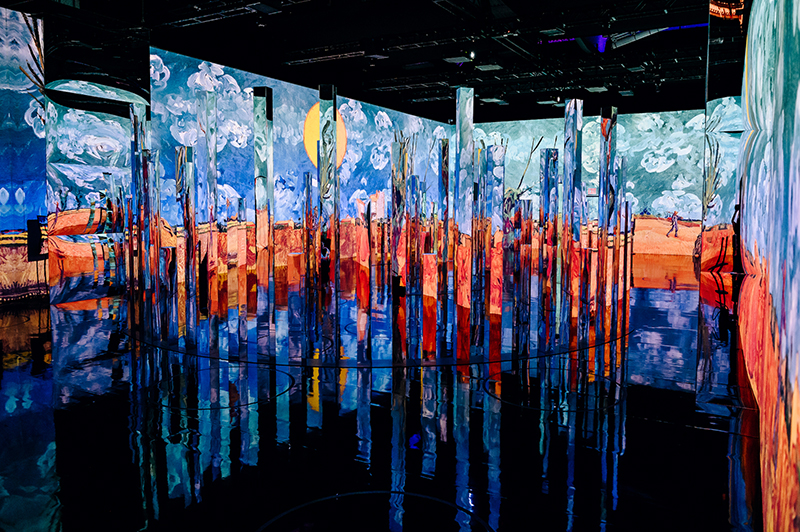
While the sculptural elements were designed by Korins to interact with the projection — and exponentially expand and create further depth to the immersive nature of the projections — they are not mapped directly in the projection design. “With the scenic elements on the floor, the projection team cut the video around them,” describes Korins. “The scenic pieces were made knowing that we were going to see the video reflected off them, not projected on to them. We created these mirrored pieces that are placed in all different areas so that when you stand and you look in them, you see yourself, but also sections of the video moving and evolving behind your head because you’re essentially looking at the wall behind you. It’s all been developed and very specifically created in this manner. We’ve put them in the space so that you can see and experience the video in a whole new way.” The scenic shop, Proof Productions, Inc., produced all the mirrored scenic elements throughout the galleries.
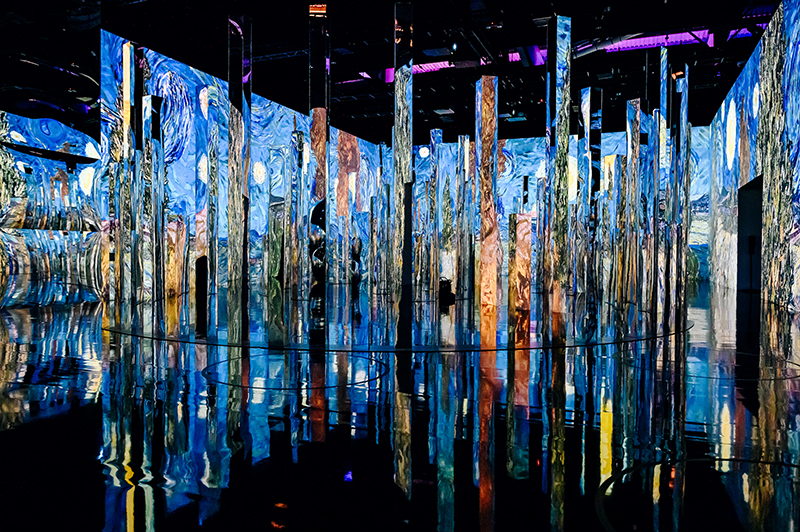
Beyond the gallery elements, Korins’ creative direction extends to the entire experience. “We designed everything from the décor, signage, wayfinding, really the entire experience you go through and all that you interact with, including all the different lobby activations.” Really infusing van Gogh and his symbolism throughout all the design elements was important to Korins, who points out, “A lot of those details that we put in — brush strokes, color, texture, and the artwork; there are sunflowers everywhere. I tried to do my 2021 artistic sensibility using iconography that we all know and love. Either we know van Gogh’s work overtly, or we know it subconsciously; I’ve laced his work into almost everything we created for this exhibition.”
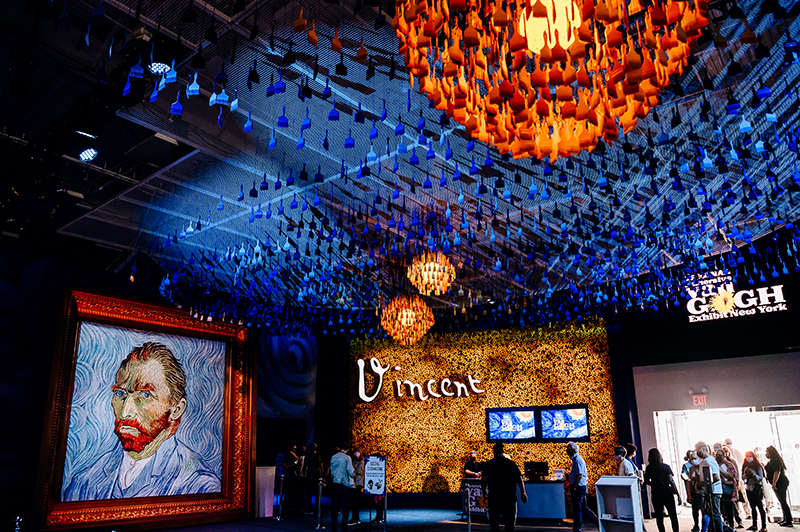
Korins looked to the art — and Siccardi’s video creations — for inspiration and his design direction. “I think what Massimiliano did was really think about what it potentially could have felt like for van Gogh in the last minutes of his life,” states Korins. “What it would be like to watch the final moments of his life flash before his eyes. I then had to take what Massimiliano made and reflect it through my own artistic sensibility. As an example, the ceiling overhead in the lobby, which is inspired by van Gogh’s The Starry Night was created using over 7,800 individually hung paintbrushes dipped in multiple colors. I think, like most people, my first interaction with van Gogh was probably seeing Starry Night, so I put the ceiling installation there in the lobby specifically. It’s my version of Starry Night overhead, like my boyhood dream, and remembering being struck, not just by the colors, but by the topography; so making that overhead was a very specific thing.” PRG Scenic Technologies provided many of the scenic elements outside the galleries, including that paintbrush ceiling, a sunflower wall, an oversized Vincent van Gogh portrait, chromesthesia booths to experience color, and an ‘Easter egg’ absinthe bar. The interactive “Letters to Vincent” activation was built by Paper Mâché Monkey.
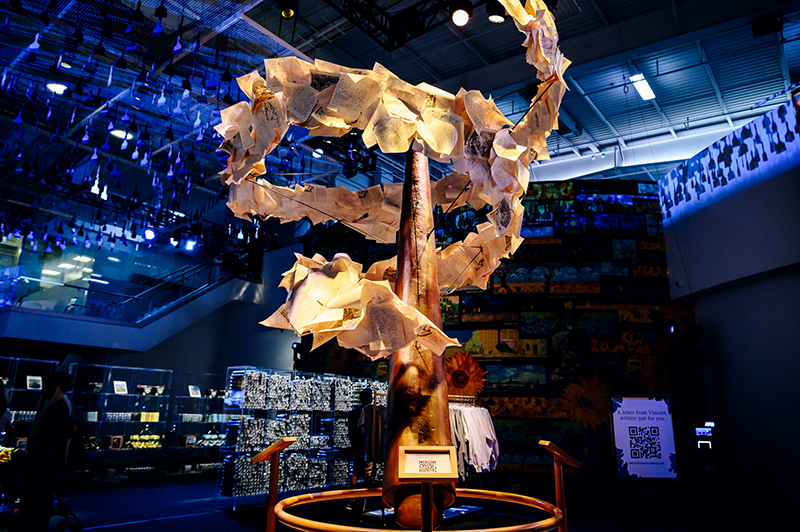
Projected Artwork
At the heart of the Immersive Van Gogh exhibit is experiencing the iconic art through immense video projections and at the core of the projection system is the PRG Mbox media server. Having first opened in Toronto, the producers turned to Toronto-based Anthony “Hoss” Headley of Down Right Technical, formerly a PRG product manager for Mbox, to realize the system. When the production moved next to Chicago, production designer and technical specialist Robb Jibson of Chicago-based So Midwest, Inc. joined the team, working alongside Headley. Jibson is overseeing the projection and media server systems for the U.S. exhibits, including the one in New York City. Beside Headley and Jibson, the projection team includes Brendan Gray of Gray Matter Visual and Tyler Roach of Eclipse Creativity as Mbox specialists, and projectionists Brooks Gotham of Gotham Professional Services, Chad Lussier of Visual Aid and Drew Winston of Logic.
To display the massive video imagery that Siccardi has designed to create the 360-degree experience, Panasonic projectors have proven to be a wise choice. By utilizing the Panasonic projector’s Edge Blending and Color Matching features, the projection team is able to match the edges of the individual projectors and create large smooth and seamless images. They can align and size the projections to the specific space as well as now cut around Korins reflective scenic elements. For the NYC exhibition, there are 94 Panasonic PT-RZ770U 1-Chip DLP laser projectors. The team takes full advantage of Panasonic’s Geometry Manager Pro software as well to precisely map the imagery, especially as many of areas took multiple projectors to create a single image. “I really love them,” says Jibson. “The Panasonic warp engine is really great. The software is really easy to use, and the projectors are really reliable. I could not imagine doing a project like this even five years ago with arc lamps and the amount of noise and heat those arc-lamped projectors would have generated. It blows me away that we have nearly 100 Panasonic projectors in the air, and you can easily have a conversation in the space.”
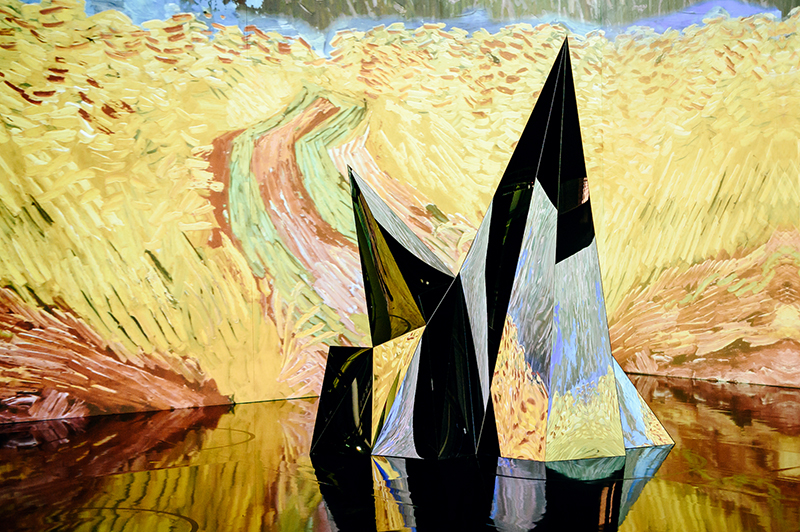
The projectors are fed the content from 24 active PRG Mbox media servers. “I’ve been a longtime Mbox user and supporter,” comments Jibson “Obviously, there are newer technologies that have come out — and we’ve learned those and use them at So Midwest — but I definitely feel that Mbox has its place. On this one, we really looked at the content that Massimiliano and the Italian content team created; the way that it has gradients, and brushstrokes, a lot of light and dark. It looked really bandy and seepy in other codecs, but in ProRes, which is still a CPU codec with the Mbox, the content just looks great.” In addition to the media servers, PRG provided the projectors, lighting, and audio.
Jibson, Headley, and the projection team, along with Massimiliano and the Italian content team, have developed and refined their processes as they’ve now worked on several iterations of the van Gogh exhibit in various cities. Among those refinements meant dealing with the new reflective sculptures in New York City’s installation. “We’ve developed a cool workflow for masking elements,” explains Jibson. “In gallery three in New York, for instance, there are big S-curve mirrored pieces. We had to trim them all out of the floor projection and not have any projection hit them. So, I’ve developed a process where I can bring my [Adobe] Illustrator Artboard live via an NDI input into the Mbox server. Then I can use my pen tablet to draw splines and make Bezier curves to knock everything out and put a little bit of a feather on it. Then I export that Artboard, and I’ve got a perfect mask that I could draw live right around the scenery. Doing that work in an offline method — taking the shapes and pieces from CAD files or photographs, and putting it in — would just be a lot of trial-and-error steps. So, I’m really happy that we were able to figure out this way to bring our drawing tools live into the media server as a live input and mask around it.” The final effect of the well-masked projections and the reflective sculptures is stunning.
Both Jibson and Korins will be continuing to work with Immersive Van Gogh team as the exhibition opens in Los Angeles, Las Vegas and other U.S. cities (more details below). Korins looks forward to the new possibilities to create in other cities, just as NYC was an opportunity, as he notes, “to further evolve a thing that already existed. What’s been really cool is to think about what people like, how they interact with it, what the IP is that we’re creating that needs to be specifically New York versus what the IP that we’re creating that needs to be specifically van Gogh. It’s been really fun to try and take some of these ideas, these now iconic images, and these interactions and activations, and now think about them, resize, rescale, and re-proportion them for other cities. I’m so excited for the future markets to get to experience these things.”
Immersing the U.S.
in Van Gogh’s Art
There are Immersive Van Gogh exhibitions all over the U.S. this year, including:
• Charlotte NC/vangoghclt.com
• Chicago/vangoghchicago.com
• Cleveland/vangoghcleveland.com
• Columbus, OH/columbusvangogh.com
• Dallas/dallasvangogh.com
• Denver/denvervangogh.com
• Detroit/detroitvangogh.com
• Houston/houstonvangogh.com
• Kansas City/kansascityvangogh.com
• Las Vegas/vangoghvegas.com
• Los Angeles/vangoghla.com
• Nashville/nashvillevangogh.com
• New York/vangoghnyc.com
• Orlando/orlandovangogh.com
• Minneapolis/vangoghmsp.com
• Phoenix/vangoghphx.com
• Pittsburgh/vangoghpittsburgh.com
• San Francisco/vangoghsf.com
Along with the Immersive Van Gogh exhibition profiled by PLSN this month, other multimedia experiences highlighting van Gogh’s art in the U.S. this year include Van Gogh: The Immersive Experience, in 10 U.S. cities; Van Gogh Alive, in Asheville, NC, Denver, Indianapolis and St. Petersburg, FL; Beyond Van Gogh: An Immersive Experience, in Austin, Detroit, Miami and Milwaukee; and Imagine Van Gogh: The Immersive Exhibition, in Tacoma/Seattle and Boston.


